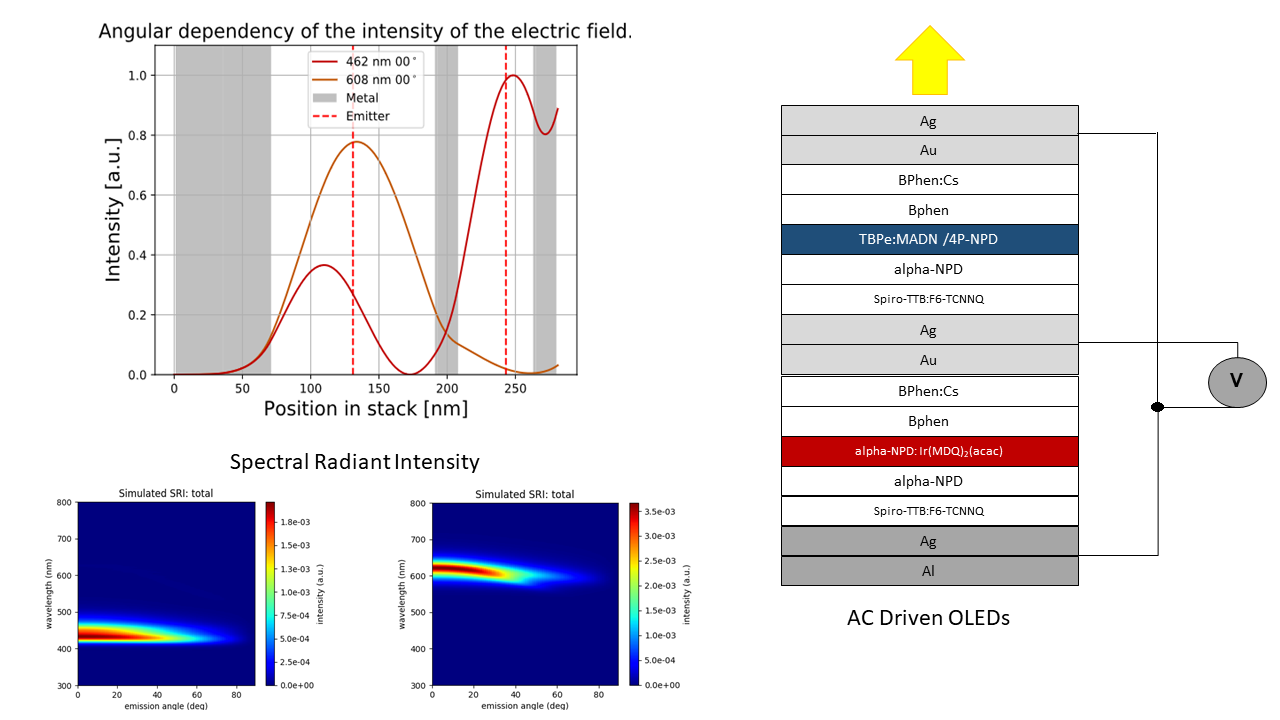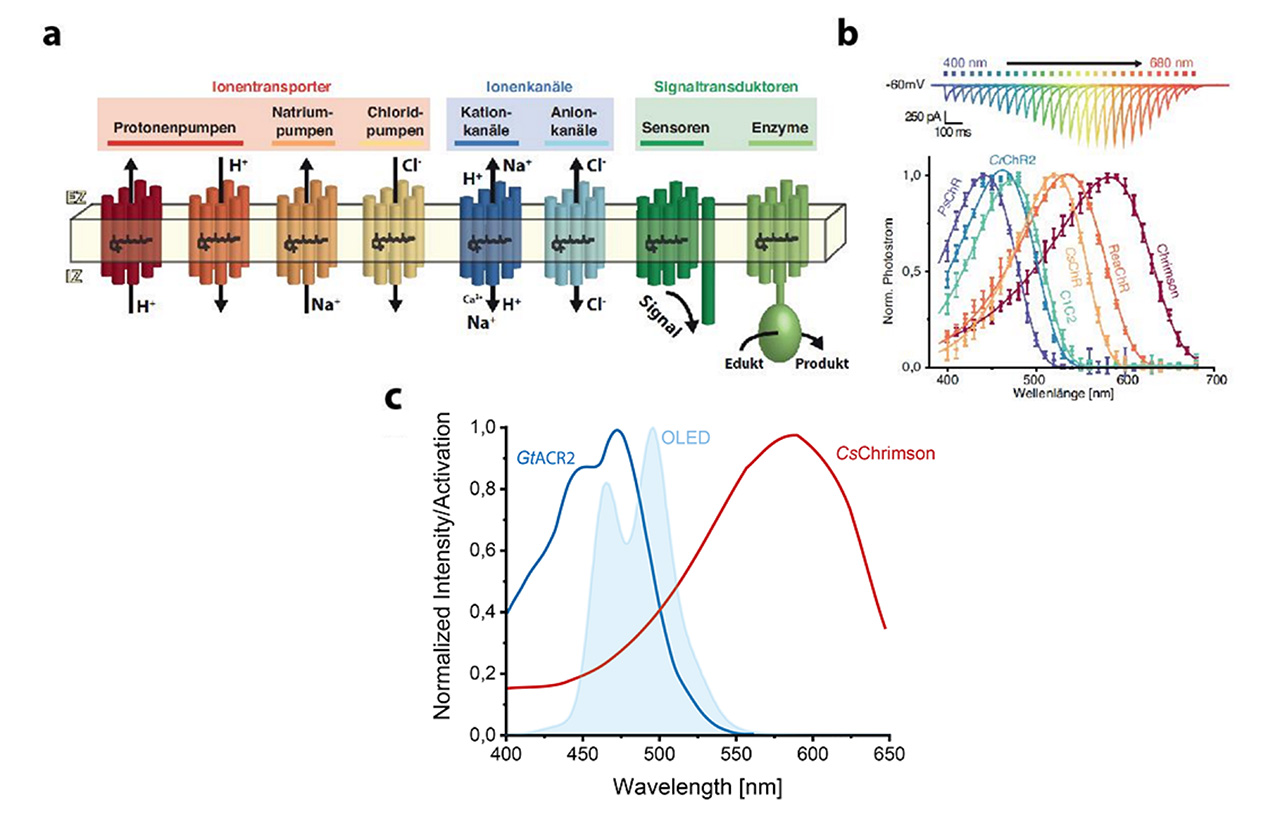High-resolution optogenetics with organic light-emitting diodes (OLEDs)
Giuseppe Ciccone – Hector Fellow Karl Leo
Rodrigo Fernandez Lahore – Hector Fellow Peter Hegemann
In this project, the application of organic light-emitting diodes (OLEDs) in optogenetics will be investigated. Several new technological approaches will be addressed to achieve optogenetic activation and inhibition of neurons with previously impossible lateral resolution. For this purpose, a new OLED technology is to be used, which can imitate electrically switchable different colours. These OLEDs will be structured into cell-sized pixels and protected against degradation by thin-film encapsulation. In combination with a matrix drive with organic transistors, it is thus possible to stimulate local opto-genetic effects in an extremely flexible way. The developed OLEDs are to be tested on new channel rhodopsins, which represent a fusion of two proteins with complementary ion conductivity. First tests will be performed on Chlamydomonas algae and HEK cells and later neuronal networks will be investigated in cell cultures and tissue sections. Here, the signal propagation within a network will be investigated, whereby individual neurons will be specifically switched on and off.
The project will be carried out in close interdisciplinary cooperation between the Hector Fellows Karl Leo, in the Department of Physics, and Peter Hegemann, in the Department of Biophysics. The two doctoral researchers involved are Giuseppe Ciccone (Technische Universität Dresden) and Rodrigo Fernande Lahore (Humboldt University of Berlin).

Giuseppe Ciccone
Doctoral student
Rodrigo Fernandez Lahore
Doctoral studentAC-driven OLEDs as optogenetic tools
Giuseppe Ciccone, Technische Universität Dresden

AC-driven OLEDs layout: simulation of the electromagnetic wave propagating in the device and its spectral radiant intensity.
Photostimulation of optogenetically modified cells provides profound selective stimulation of their electrical activity and interdependence. While a plethora of devices have been proposed for optogenetics, AC-driven organic light emitting diodes (OLEDs) are examined in this project as optogenetic tools with the unprecedented stability in biological environment, high spatial resolution, and their possibility to induce both enhancement and inhibition via on-demand color emission.
Activation and inhibition of neurons with previously unattainable spatial resolution can be triggered with two different colors by using a new technology that exploits AC-driven OLEDs structured into micro-pixels and protected against degradation with thin encapsulation. The architecture of these devices will be tailored according to the absorption spectra of excitatory and inhibitory state of the art photosystems. Moreover, the devices will be tested on in vitro models to trigger their electrical responses. With a view on future in vivo tests, biodegradable substrates will be examined as devices supports for further implantation in model animals.
Photoactivation of neurons using channelrhodopsins
Rodrigo Fernandez Lahore, Humboldt University of Berlin

a) Overview of the most important microbial rhodopsins.
b) Normalized photocurrents of selected channelrhodopsins at different activation wavelengths in comparison to red-shifted CsChrimson.
c) Spectrum of a blue-light emitting OLED overlaid with the action spectra of GtACR2 and CsChrimson.
Sources: a) and b) J. Vierock, PhD Thesis, Humboldt-Universität Berlin, 2019
c) Courtesy of Caroline Murawski
Due to the speed of complex neuronal networks, their study requires tools which enable precise spatial and temporal control of their processes. Using light-gated ion channels named channelrhodopsins (ChRs) originally found in unicellular algae, it is possible to switch neurons on and off with the use of e.g. lasers and LEDs in a field known as optogenetics.
This project is concerned with the testing of organic LEDs (OLEDs), which emit both blue and red light, for applications in optogenetics. For this purpose, cells expressing either fused or separated blue-shifted GtACR2 and red-shifted CsChrimson are exposed to OLEDs (provided by cooperation partner HF Prof. Dr. Karl Leo). The separate activation of the two channel rhodopsins with a single OLED on a single cell scale will be tested. First, experiments will be performed in animal cell culture (HEK293 and ND7/23 cells) and after advanced optimization the OLEDs will be tested for use in neurons.
Supported by

Karl Leo
PhysicsHector Fellow since 2013

Peter Hegemann
Biology, Chemistry & MedicineHector Fellow since 2015


